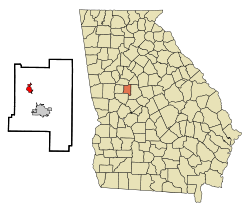Milner, Georgia
Milner, Georgia | |
|---|---|
 Location in Lamar County and the state of Georgia | |
| Coordinates: 33°6′47″N 84°11′42″W / 33.11306°N 84.19500°W | |
| Country | United States |
| State | Georgia |
| County | Lamar |
| Area | |
• Total | 2.08 sq mi (5.39 km2) |
| • Land | 2.07 sq mi (5.37 km2) |
| • Water | 0.01 sq mi (0.02 km2) |
| Elevation | 840 ft (256 m) |
| Population (2010) | |
• Total | 610 |
• Estimate (2019)[2] | 654 |
| • Density | 315.48/sq mi (121.82/km2) |
| Time zone | UTC-5 (Eastern (EST)) |
| • Summer (DST) | UTC-4 (EDT) |
| ZIP code | 30257 |
| Area code | 770 |
| FIPS code | 13-51604[3] |
| GNIS feature ID | 0332395[4] |
| Website | milnerga |
Milner is a city in Lamar County, Georgia, United States. The population was 610 at the 2010 census,[5] up from 522 at the 2000 census.
History
The community was named after Willis R. Milner, a pioneer citizen.[6]
Geography
Milner is located in northwestern Lamar County at 33°6′47″N 84°11′42″W / 33.11306°N 84.19500°W (33.112941, -84.195017).[7] U.S. Route 41 passes through the southwest side of the city, leading southeast 5 miles (8 km) to Barnesville, the Lamar county seat, and northwest 11 miles (18 km) to Griffin.
According to the United States Census Bureau, the city has a total area of 2.1 square miles (5.4 km2), all land.[8] The city sits on the Eastern Continental Divide, with the east side draining via Prairie Creek and Edie Creek to the Little Towaliga River, the Towaliga River, the Ocmulgee River, and ultimately the Atlantic Ocean, while the west side drains via Grape Creek to Potato Creek, the Flint River, and ultimately the Gulf of Mexico.
Demographics
| Census | Pop. | Note | %± |
|---|---|---|---|
| 1880 | 442 | — | |
| 1900 | 440 | — | |
| 1910 | 400 | −9.1% | |
| 1920 | 407 | 1.8% | |
| 1930 | 329 | −19.2% | |
| 1940 | 352 | 7.0% | |
| 1950 | 345 | −2.0% | |
| 1960 | 305 | −11.6% | |
| 1970 | 270 | −11.5% | |
| 1980 | 320 | 18.5% | |
| 1990 | 321 | 0.3% | |
| 2000 | 522 | 62.6% | |
| 2010 | 610 | 16.9% | |
| 2019 (est.) | 654 | [2] | 7.2% |
| U.S. Decennial Census[9] | |||
As of the census[3] of 2000, there were 522 people, 189 households, and 145 families residing in the city. The population density was 372.0 people per square mile (144.0/km2). There were 201 housing units at an average density of 143.2 per square mile (55.4/km2). The racial makeup of the city was 72.61% White, 26.44% African American, 0.19% Native American, 0.57% Asian, and 0.19% from two or more races.
There were 189 households, out of which 34.4% had children under the age of 18 living with them, 59.3% were married couples living together, 15.3% had a female householder with no husband present, and 22.8% were non-families. 21.2% of all households were made up of individuals, and 7.9% had someone living alone who was 65 years of age or older. The average household size was 2.76 and the average family size was 3.19.
In the city, the population was spread out, with 27.2% under the age of 18, 10.2% from 18 to 24, 30.5% from 25 to 44, 22.0% from 45 to 64, and 10.2% who were 65 years of age or older. The median age was 34 years. For every 100 females, there were 89.8 males. For every 100 females age 18 and over, there were 87.2 males.
The median income for a household in the city was $42,222, and the median income for a family was $44,375. Males had a median income of $31,328 versus $19,625 for females. The per capita income for the city was $17,819. About 6.5% of families and 6.8% of the population were below the poverty line, including 10.9% of those under age 18 and 5.0% of those age 65 or over.
References
- ^ "2019 U.S. Gazetteer Files". United States Census Bureau. Retrieved July 9, 2020.
- ^ a b "Population and Housing Unit Estimates". United States Census Bureau. May 24, 2020. Retrieved May 27, 2020.
- ^ a b "U.S. Census website". United States Census Bureau. Retrieved 2008-01-31.
- ^ "US Board on Geographic Names". United States Geological Survey. 2007-10-25. Retrieved 2008-01-31.
- ^ "Profile of General Population and Housing Characteristics: 2010 Census Summary File 1 (DP-1), Milner city, Georgia". American FactFinder. U.S. Census Bureau. Archived from the original on February 13, 2020. Retrieved December 6, 2019.
- ^ Krakow, Kenneth K. (1975). Georgia Place-Names: Their History and Origins (PDF). Macon, GA: Winship Press. p. 148. ISBN 0-915430-00-2.
- ^ "US Gazetteer files: 2010, 2000, and 1990". United States Census Bureau. 2011-02-12. Retrieved 2011-04-23.
- ^ "U.S. Gazetteer Files: 2019: Places: Georgia". U.S. Census Bureau Geography Division. Retrieved December 6, 2019.
- ^ "Census of Population and Housing". Census.gov. Retrieved June 4, 2015.

